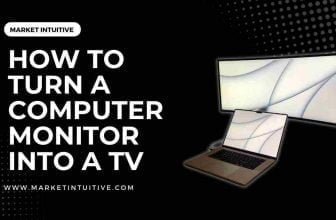How To Mount Monitor Without VESA: Explained In Simple Steps

VESA stands are common on new monitors, but many computers don’t have the right port to connect them. Setting up a new monitor can be extremely frustrating if your computer doesn’t have the right port to connect it. This article guides you on how to mount monitor without VESA mounts.
Consult your owner’s manual before beginning to ensure you have the correct mounting equipment. With patience and the proper tools, your monitor will be up and running in no time.
What Is a VESA Mount?
A VESA mount is a bracket connecting a computer to a monitor. It is widely compatible with most monitors, making it a popular choice among those seeking an easy connection solution.
You must use a VESA mount if your computer doesn’t have the right port to connect your monitor.
What Is a Non-VESA Monitor Mount?
Without using the VESA mount, Non-VESA monitor mounts attach a monitor to a computer.
This bracket type is less common than the VESA mount, but it may be helpful if your computer does not have the proper port to connect your computer monitor.
Why Do You Need to Mount Your Monitor?
You need to mount your monitor because of the following reasons:
- Dual-monitor setup
You must mount one of the monitors and set up a dual-monitor system if you want to use two monitors side by side.
- Desk Space
The monitor mounted to the stand makes the work easy and helps free up desk space.
- Protection
Your monitor is less susceptible to damage on proper mounting.
- Improve Ergonomics
You can position the monitor at the optimal height and angle for your needs to reduce neck and eye strain.
- Security
If you’re worried about your monitor being stolen, mounting it will deter criminals.
- Productivity
You will work more efficiently when your monitor is in the right position.
Note: Ensure your monitor’s VESA adapter is compatible with your monitor without any problems. Be careful, especially about the monitor’s weight and dimensions.
The base stand of some monitors has screws inside, which increases the risk of damaging the monitor if you are not careful.
You can mount your non-VESA monitor using the VESA adapter. Use the adjustable clamps and screw the fixed plates into the VESA adapter.
Note: The monitor might slip from the adapter kit if you notice any slipping signs. Use anti-slip rubber pads between the monitor and adapter plates to keep the monitor firmly attached.
Comparison of Non-VESA & VESA Mounts
You know the difference between a VESA mount and a non-VESA mount, so which one is right for you? Here’s a quick comparison:
VESA Mounts
- Relatively easy to find and affordable.
- Simple to install.
- A standard for connecting monitors to computers.
- Position your monitor exactly how you want, using a variety of adjustability.
Non-VESA Mounts
- Costly than VESA mounts.
- Non-VESA monitors are difficult to mount.
- They are not as popular as VESA mounts.
- Offers less adjustability than VESA mounts.
Can You Attach a Non-VESA Mount to a VESA Monitor?
There are adapters available that allow to attach of non-VESA mounts to VESA monitors. These adapters are relatively inexpensive and straightforward to install.
If you have the right adapter, use Non-VESA mounts with VESA-compatible monitors.
An adapter kit from VESA is required to mount most LCD monitors up to 27 inches without a VESA mount. The kit includes an adapter plate, screws, washers, and spacers.
You don’t need any special tools to install the VESA adapter. It’s a great choice if you wish to mount a VESA-compatible monitor to a non-VESA mount.
If you’re using an adapter, keep these points in mind:
- An adapter may not offer as much flexibility as a VESA mount.
- An adapter mount may not be as sturdy as a Vesa mount.
Finding an adapter that matches your unique monitor may be challenging if you don’t use a VESA mount. You must also carefully read the adapter instructions to ensure you’re using it properly.
Which Mount Is Right for Me?
When you understand the VESA mount and non-VESA mount distinctions, you may want to know which one is right for you. Here are some factors to think about:
Weight of Monitor
When choosing a mount, ensure it supports your monitor’s weight. VESA mounts are typically very sturdy to support heavier monitors.
Keep in mind that non-VESA mounts may not be able to support as much weight when choosing a mount.
Type of Mount
Mounts are of two types: fixed and adjustable. VESA mounts offer a lot of flexibility, providing lots of adjustability. If you want less adjustability, a non-VESA mount might be preferable.
Size of Monitor
A VESA mount is probably the best option if your monitor is large. Non-VESA mounts are less adjustable than VESA mounts.
Skills
Non-VESA mounts are a good choice if you’re comfortable doing DIY projects. They may be more challenging to install than VESA mounts.
Budget
Non-VESA mounts might be the best choice if you’re on a tight budget. They tend to be cheaper than VESA mounts.
Can You Use a Converter Box to Convert a Non-VESA Mount to a VESA mount?
You can use a converter to connect a non-VESA mount to a VESA-compatible monitor. Converters are available in fixed or adjustable formats.
Converters are not as common as adapters, so they may be hard to locate. They also may not offer as much adjustability or support as much weight.
Pros & Cons of Non-VESA Mounts
Where To Buy a VESA Adapter Kit
There are numerous Vesa adapter kits available in the market. You may purchase one from an electronics store or online.
Online shopping is preferable as you may purchase at a reduced price and choose from various brands. Furthermore, shop from the comfort of your home or office, and the delivery can be straight to your door.
Finding the right adapter is simple. Some adapters are universal and can be used with most flat-screen monitors. Visit Amazon or another reputable online store and look for your specific monitor model.
FAQs(Frequently Asked Questions) on How to Mount Monitor Without VESA
1. Can you mount a monitor that doesn’t have VESA?
Yes, you can use non-VESA mounts with VESA monitors. You’ll need to purchase an adapter. These adapters are generally inexpensive and simple to install. You can use adapters if you want to use a VESA mount on a non-VESA monitor.
2. Do all monitors have VESA mount?
Many modern flat-panel monitors and TVs are VESA-compliant. Check the back of your computer monitor to see if it adheres to VESA standards. You will see the standard four-screw pattern on the back if it does.
3. What is the standard VESA size?
TV brackets and wall mounting systems are typically compatible with the VESA standard. For 60 inch TVs, VESA 400 x 400 & VESA 600 x 400 and for 32 inch TVs, VESA 200 x 200 are common sizes.
4. What are non-VESA monitors?
Non-VESA monitors are computers that do not use the VESA standard mount to attach a monitor.
5. Can you use a VESA mount with a non-VESA monitor?
You can use an adapter to use non-VESA monitors with a VESA mount.
6. Which type of mount is right for me?
It depends on your needs. A VESA mount is probably the best option if you have a big monitor. A non-VESA mount may be better if you have a small monitor or are on a budget.
7. Which best way to attach a non-VESA monitor to a VESA stand?
You can use an adapter to convert Non-VESA mounts to VESA-compatible mounts. Alternatively, use a convertor box to convert a non-VESA monitor to a VESA stand.
8. What’s the meaning of VESA 100 x 100?
The distance of 100 millimeters between each hole on the back of a monitor is VESA 100 x 100. In other words, the vertical and horizontal intervals of the screw holes are both 100 millimeters.
9. Are all monitors mountable?
Yes, all monitors can be mountable. Modern monitors include mounting plates or VESA mounting holes on the back (VESA standards). You can use VESA adapters if an older monitor doesn’t come with a VESA adapter.
10. Can I use a TV mount for a monitor?
Using VESA standards, you can easily attach a monitor to a TV mount for the table or the wall. Make sure the mount is compatible with the monitor in terms of weight and size.
11. Are computer monitors universal?
Your computer can connect to any monitor if the connecting ports are compatible. Modern TV sets generally have HDMI, VGA, or DVI inputs so that you can use them as monitors.
12. Should I wall mount my monitor?
The wall-mounted monitor provides lots of advantages. It looks nice and saves space by eliminating wires and cables from cluttering up the space. Your workspace appears neat when you mount your monitor.
Related Topics:
- 8 Best 240 Hz Monitor In 2022 [Tested & Compared]
- 12 Best Vertical Monitor To Gain More Productivity
- 11 Best Monitor for Eye Strain: How to Prevent Computer Eye Strain
- IPS vs LED Monitor: Which One is Best For You?
Summary: How to Mount Monitor Without VESA
The method described above is how to mount monitor without VESA compatibility.
VESA adapter kits are the only reliable way to mount non-VESA-compatible monitors. You can easily mount a non-VESA monitor using this kit.
It includes four easy steps. You must locate the tools, remove the base stand, attach the VESA adapter to the arm mount, and mount the monitor.
No need to purchase a new screen. Buy the kit!






